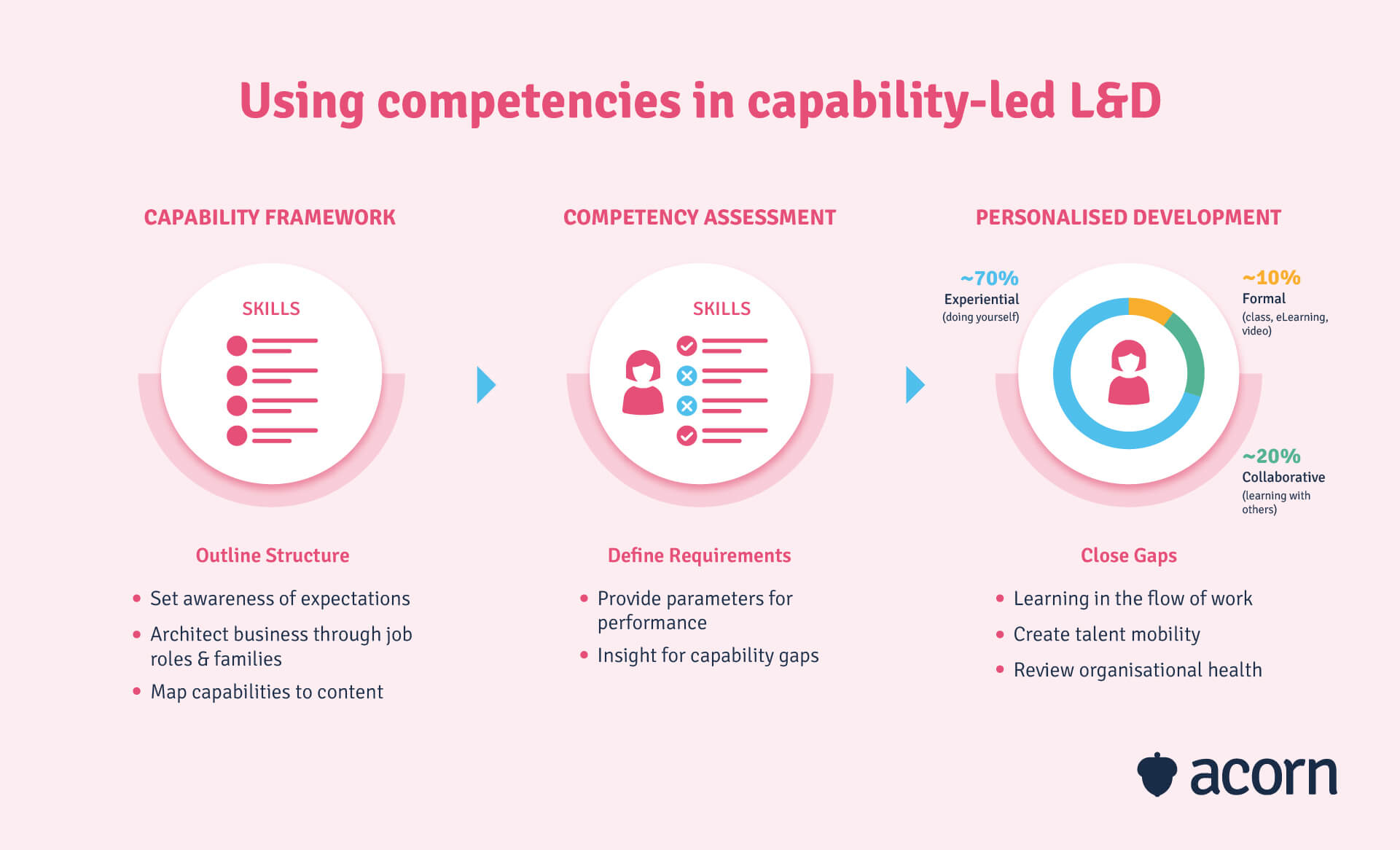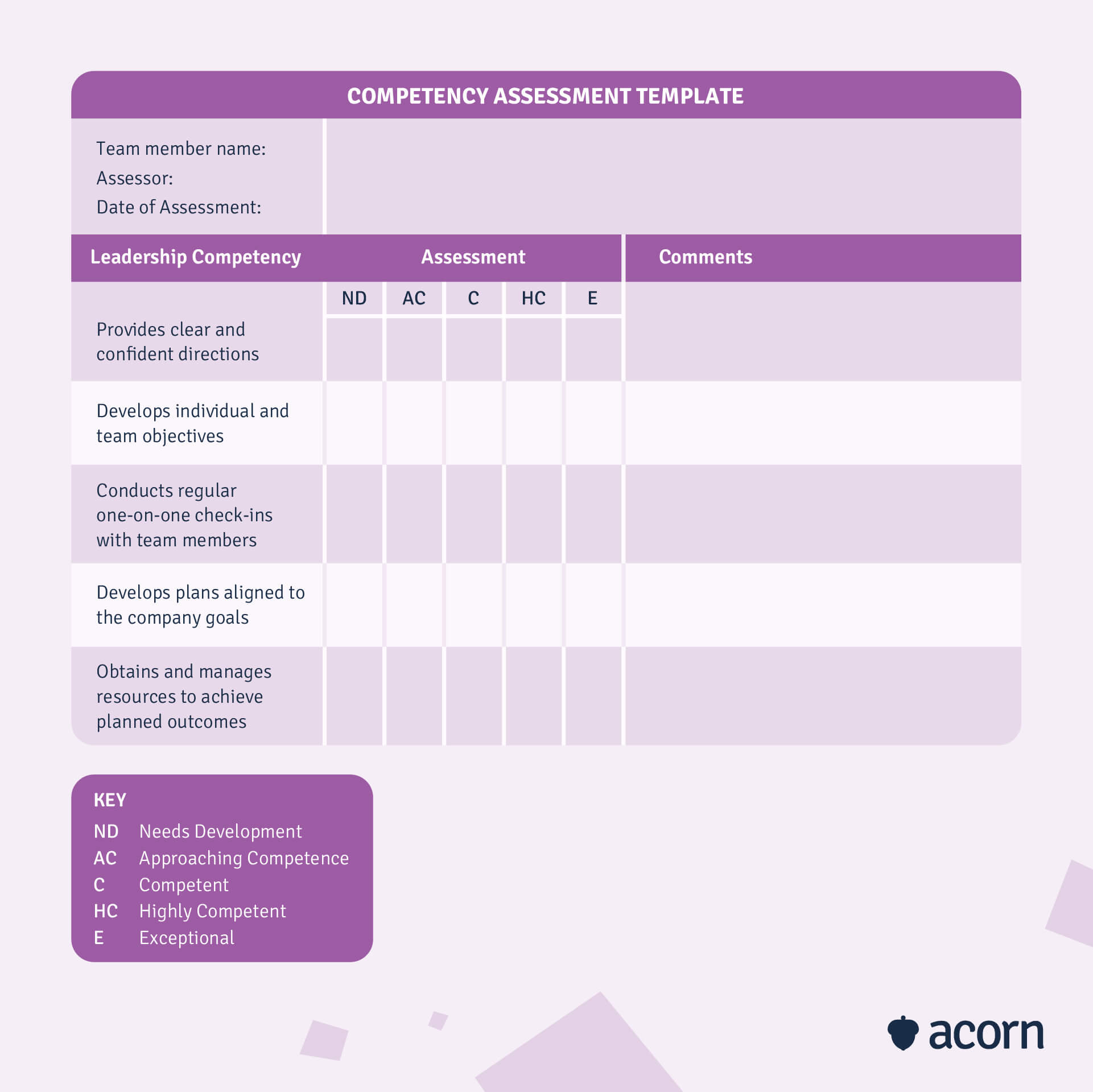Why Competency Management is Important for Strategic Performance Management
Reading Time:

Lead the pack with the latest in strategic L&D every month— straight to your inbox.
SubscribeCompetency management is the key to strategic performance management and uncovering capability gaps in your workforce.
Contrary to some popular beliefs, competency is not a collection of skills, behaviours and knowledge (that’s a capability). But it is a measure of how a capability is performed against your organisation’s needs, making competency management an integral part of any capability-led L&D strategy.
Competency management is easier to implement and utilise than you may think. It starts with understanding what ideal performance looks like, figuring out how you’ll assess performance and uncover capability gaps, and ends with identifying the best learning pathways to address any gaps in performance uncovered. Let’s get into it.
What is competency management?
Competency management is the process of identifying to what level of competence employees perform a capability. This is done through continuous capability assessments and development.
What do we mean by competency?
There are plenty of conflicting definitions of competency and its role in business strategy out there.
Competency is essentially a key measure of performance. That is, competency is how someone performs a capability or a set of knowledge, skills and behaviours. The capability is the what, and competency is the how.
If you think back to school, you may be familiar with a competency model like A-D or distinction to fail grading scales. In the workplace, it’s closer to terminology like proficient, intermediate and advanced, or tied to job families like team member and executive.
What do we mean by strategic performance management?
It differs from your normal performance management mechanisms in its capability-led approach.
- Standard performance management (while important) sets expectations through job descriptions, monitors the development of employees’ skills and rewards outstanding performance.
- Strategic performance management links employee performance to organisational goals. This is done to ensure that the organisation retains its competitive advantage with sustainable, efficient and effective realisation of its capabilities.
It’s also different again from talent management, which as a whole focuses on strategies like employee retention, recruitment and succession planning.
Why is competency management important?
Capabilities are a dynamic business resource as much as a structured framework for business strategy. But what gives them that dynamism is competency.
Conversely, competencies are a fixed goal. While an employee can progress through competencies, there is generally an upper limit to the performance standard expected. That provides a map for employees to align their behaviours against.
This is to say that competency management is firmly in the centre of performance and talent management. Consider who and what that touches: Managers, individual contributors, recruitment, L&D, capacity planning, retention, compliance, succession and career planning, even internal messaging and culture.
But most important of all, managing employee performance comes back to business performance. If, at the molecular level, employees aren’t performing as has been defined as necessary for business success, then the business itself doesn’t have a leg to stand on other than maintaining its current state.
This is why we’ve pioneered the first performance learning management system (PLMS) here at Acorn. A PLMS is a dynamic AI-powered platform for synchronising L&D experiences business performance by codifying and operationalising capabilities to improve organisational efficiency and empower employees to become high impact players in the business.
The benefits of competency management
Beyond its importance in developing organisational capability, competency management has its advantages at the workforce level. That’s:
- Autonomy and self-sufficiency for employees managing their own development
- More personalised learning journeys for employees
- Internal benchmarking of performance across functions and locations
- Universal language around performance standards
- More accurate L&D outcomes and better insights for process improvements.
The competency management process in the workplace
End-to-end, competency management takes place almost entirely within the workplace. (After all, the thing we’re managing here is performance.)
It plays out in a pretty structured way, if you’re aiming for capability development through performance improvement.

Define your competency framework
If you’re starting from scratch (with or without a capability framework), then your first point of contact is to break down capabilities by tasks and behaviours. This gives you the framework from which to outline competency.
Think back to our examples of competency models earlier. You might go the grade route, wherein you break it down with language like foundational, proficient and advanced. This is generally helpful when capabilities are more fluid across job roles.
The second way to define competency is via job role, with ascending competencies based on a certain progression. The public sector often uses this approach to support the clear career pathways they offer.
In either approach, remember that the description of a competency is a performance indicator of a certain job task or behaviour. The task or behaviour is a capability.
Conduct a competency assessment
Assessment is the backbone of this process and the core of what any competency management system can do. It’s also a good way to ensure you’ve got accurate and clearly defined competencies to begin with.
Start with a list of questions or statements related to capabilities created by HR or L&D. The aim is seek gaps in performance, so the leading statements or questions used don’t need to be complex. Many templates out there will guide you to simply provide the competency descriptor and a rating scale alongside it.

There are a few different ways that the questions can be answered and those answers utilised: Self-assessment, manager assessment or system review.
The most common process is one you’re likely already using. Performance reviews with managers can be bolstered with this template, or managers can simply state what proficiency level an employee is at.
Some competency management systems will aggregate this information for you visually, so you can see competency matrices for individual employees or by capability. Self-assessments would generally be used during professional development as a reflection exercise, as they create less impartial data.
Identify development needs
Now that you’ve measured the gaps between reality and successful job performance, the next stage of this process is developing employee competencies to the required standard of one’s job or professional development.
The key is to work capability by capability. Each capability will have its core competencies, and if you’ve got the right tech, content that is mapped to said capability or each level of competency.
For example, say you’ve gone with a competency framework defined by career trajectory as in the public sector examples. There’s a parent capability of Achieves Results with the sub-capability Optimally Manages Resources. The foundational competency under that may be Adheres to project deadlines. Now say you’ve got an individual contributor who is on track to succeed their manager. But the next essential competencies are Uses other employee skills effectively and Monitors project progress against performance expectations—which assessments have shown they’re not proficient in. There’s the starting point or next stage for their professional development.
Developing and implementing a competency model
Competency management practices don’t often occur naturally, especially if you’ve never formalised them before. Ensuring it’s done right (in order to glean accurate capability data) comes with a few dos and don’ts.
Do: Automate the process
Competency management systems or software have two benefits.
- They save the hassle of manual data collection and analysis.
- They provide mode powerful data collection and analysis.
Recall that we mentioned some systems will enable you to map learning content to capabilities and competencies? Look for tools such as a learning management system that offer robust assessment functionality and integrations with HR tech. This makes it easier to collate your people data and easily analyse learning data to ascertain ROI for stakeholders.
Do: Market internally
If you’re introducing competencies and capabilities for the first time, there may be some trepidation about their impact. Particularly for managers conducting performance reviews and employees undergoing professional development, newly defined competencies will change the way things are done.
User guides are one way you can market competency models internally. Break them down by potential tasks, such as applying for a role or managing team performance.
Don’t: Complicate your competencies
Like their parent capabilities, competencies don’t need to be complicated to be exhaustive. The idea is to define application of a capability at different performance levels.
As we mentioned, you can segment competencies in a couple of ways.
- By proficiency level
- By job family.
In either category, just remember that competencies are cumulative. The latter may ascend through team member, team leader, specialist and executive. A team leader would need to have successfully demonstrated the competency or competencies under team member as well as under team leader.
Don’t: Forget to review
Most private businesses abide by a set-and-forget approach to capabilities, and by default, competencies. However, the public sector generally review their frameworks every few years in line with updated workforce plans.
It won’t shatter the stability of your organisation to revisit competencies, especially since they are behavioural indicators. Consider your leadership competencies—as the business landscape changes, technology emerges and challenges evolve, leaders will need to adapt their performance.
Key takeaways
As with all good business planning, you should be getting strategic with performance management. That doesn’t mean throwing out performance reviews or KPIs, rather supercharging them for your organisational goals.
Competency provides a standard against which employees and managers can measure job performance. Competency management is then about assessing and developing the gaps in performance that arise.
It can be easy to conflate capability with competency. Remember that a capability is what your organisation needs to be doing (driving results, customer management, leading innovation) and competency is a measure of how well employees perform those capabilities. Capabilities, as a business tool, need competency to be understood by employees.